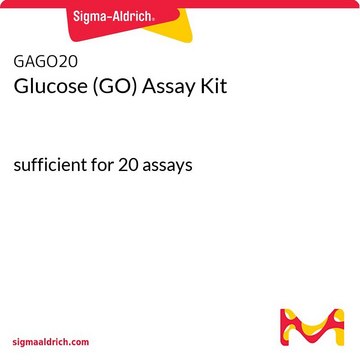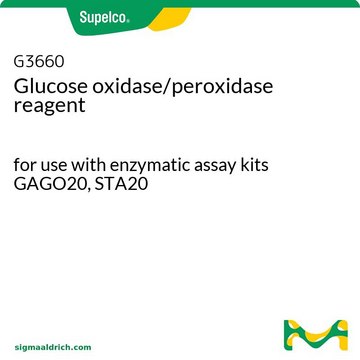MAK542
Glucose Uptake Assay Kit
sufficient for 100 colorimetric tests
Synonym(s):
Glucose Uptake Colorimetric Detection Kit
Sign Into View Organizational & Contract Pricing
All Photos(1)
About This Item
UNSPSC Code:
41116104
NACRES:
NA.25
Recommended Products
detection method
colorimetric
relevant disease(s)
endocrinological disorders, diabetes; cancer
shipped in
wet ice
storage temp.
−20°C
Related Categories
General description
Glucose is the primary energy source for most cells, and its uptake is a highly regulated process that represents the first rate-limiting step in glucose metabolism. This uptake is facilitated by the GLUT family of transporter proteins, which include various isoforms that are tissue-specific and respond to different physiological conditions. The expression and activity of these transporters are modulated by several factors, including insulin, exercise, and cellular energy status. In many cancer cells, glucose uptake is significantly upregulated, resulting in increased rates of aerobic glycolysis, a phenomenon known as the Warburg effect, which supports rapid cell proliferation. Conversely, cells with insulin resistance demonstrate diminished glucose uptake in response to insulin stimulation, contributing to metabolic disorders such as diabetes. Glucose transport systems are essential for moving glucose across cell membranes, ensuring its availability for energy production and metabolic processes. Measuring the uptake of 2-deoxyglucose (2-DG), a glucose analog, is widely recognized as a reliable method for estimating glucose uptake and exploring the regulation of glucose metabolism and the underlying mechanisms of insulin resistance.
Suitability
The Glucose Uptake Assay Kit provides a sensitive colorimetric assay for biological samples such as tissue or cultured cells.
Principle
In this assay, 2-DG is taken up by glucose transporters and metabolized to 2-DG-6-phosphate (2-DG6P). The non-metabolizable 2-DG6P accumulates in the cells and is proportional to glucose uptake by cells. The accumulated 2-DG6P is enzymatically oxidized and generates NADPH, which is specifically monitored by a chromogenic NADPH sensor. The signal can be read by a spectrophotometric plate reader by reading the OD ratio at wavelength 570 nm to 610 nm.
Signal Word
Warning
Hazard Statements
Precautionary Statements
Hazard Classifications
Aquatic Chronic 3 - Eye Irrit. 2 - Met. Corr. 1 - Skin Irrit. 2
Storage Class Code
8A - Combustible corrosive hazardous materials
WGK
WGK 3
Regulatory Information
新产品
Choose from one of the most recent versions:
Certificates of Analysis (COA)
Lot/Batch Number
It looks like we've run into a problem, but you can still download Certificates of Analysis from our Documents section.
If you need assistance, please contact Customer Support.
Already Own This Product?
Find documentation for the products that you have recently purchased in the Document Library.
Our team of scientists has experience in all areas of research including Life Science, Material Science, Chemical Synthesis, Chromatography, Analytical and many others.
Contact Technical Service

![2-Deoxy-2-[(7-nitro-2,1,3-benzoxadiazol-4-yl)amino]-D-glucose ≥97% (HPLC)](/deepweb/assets/sigmaaldrich/product/structures/104/527/40bd5a41-ebc4-484e-a10e-891fecfaea79/640/40bd5a41-ebc4-484e-a10e-891fecfaea79.png)

